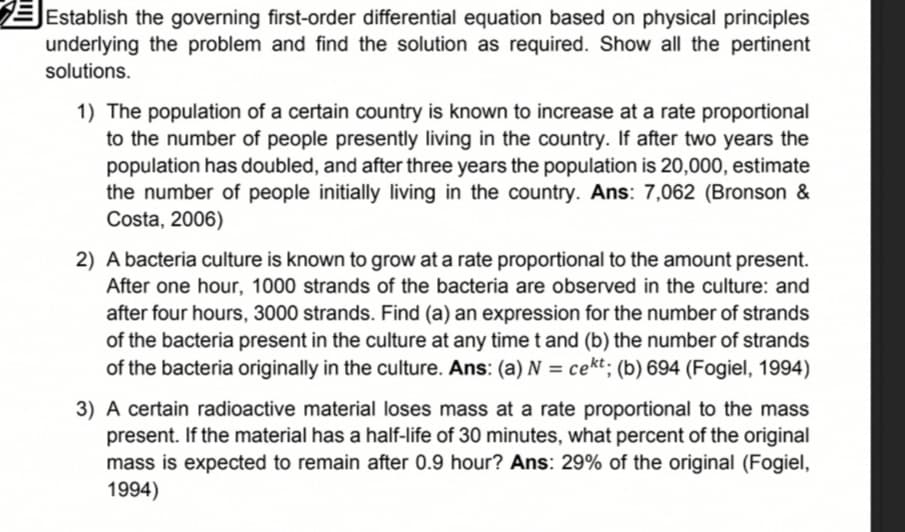1) The population of a certain country is known to increase at a rate proportional to the number of people presently living in the country. If after two years the population has doubled, and after three years the population is 20,000, estimate the number of people initially living in the country. Ans: 7,062 (Bronson & Costa, 2006)
1) The population of a certain country is known to increase at a rate proportional to the number of people presently living in the country. If after two years the population has doubled, and after three years the population is 20,000, estimate the number of people initially living in the country. Ans: 7,062 (Bronson & Costa, 2006)
Calculus: Early Transcendentals
8th Edition
ISBN:9781285741550
Author:James Stewart
Publisher:James Stewart
Chapter1: Functions And Models
Section: Chapter Questions
Problem 1RCC: (a) What is a function? What are its domain and range? (b) What is the graph of a function? (c) How...
Related questions
Question
Plsss answer subparts 1 and 2 with written solution. Thanksss! ❤️

Transcribed Image Text:Establish the governing first-order differential equation based on physical principles
underlying the problem and find the solution as required. Show all the pertinent
solutions.
1) The population of a certain country is known to increase at a rate proportional
to the number of people presently living in the country. If after two years the
population has doubled, and after three years the population is 20,000, estimate
the number of people initially living in the country. Ans: 7,062 (Bronson &
Costa, 2006)
2) A bacteria culture is known to grow at a rate proportional to the amount present.
After one hour, 1000 strands of the bacteria are observed in the culture: and
after four hours, 3000 strands. Find (a) an expression for the number of strands
of the bacteria present in the culture at any timet and (b) the number of strands
of the bacteria originally in the culture. Ans: (a) N = cekt; (b) 694 (Fogiel, 1994)
%3D
3) A certain radioactive material loses mass at a rate proportional to the mass
present. If the material has a half-life of 30 minutes, what percent of the original
mass is expected to remain after 0.9 hour? Ans: 29% of the original (Fogiel,
1994)
Expert Solution
This question has been solved!
Explore an expertly crafted, step-by-step solution for a thorough understanding of key concepts.
Step by step
Solved in 3 steps with 3 images

Recommended textbooks for you

Calculus: Early Transcendentals
Calculus
ISBN:
9781285741550
Author:
James Stewart
Publisher:
Cengage Learning

Thomas' Calculus (14th Edition)
Calculus
ISBN:
9780134438986
Author:
Joel R. Hass, Christopher E. Heil, Maurice D. Weir
Publisher:
PEARSON

Calculus: Early Transcendentals (3rd Edition)
Calculus
ISBN:
9780134763644
Author:
William L. Briggs, Lyle Cochran, Bernard Gillett, Eric Schulz
Publisher:
PEARSON

Calculus: Early Transcendentals
Calculus
ISBN:
9781285741550
Author:
James Stewart
Publisher:
Cengage Learning

Thomas' Calculus (14th Edition)
Calculus
ISBN:
9780134438986
Author:
Joel R. Hass, Christopher E. Heil, Maurice D. Weir
Publisher:
PEARSON

Calculus: Early Transcendentals (3rd Edition)
Calculus
ISBN:
9780134763644
Author:
William L. Briggs, Lyle Cochran, Bernard Gillett, Eric Schulz
Publisher:
PEARSON

Calculus: Early Transcendentals
Calculus
ISBN:
9781319050740
Author:
Jon Rogawski, Colin Adams, Robert Franzosa
Publisher:
W. H. Freeman


Calculus: Early Transcendental Functions
Calculus
ISBN:
9781337552516
Author:
Ron Larson, Bruce H. Edwards
Publisher:
Cengage Learning